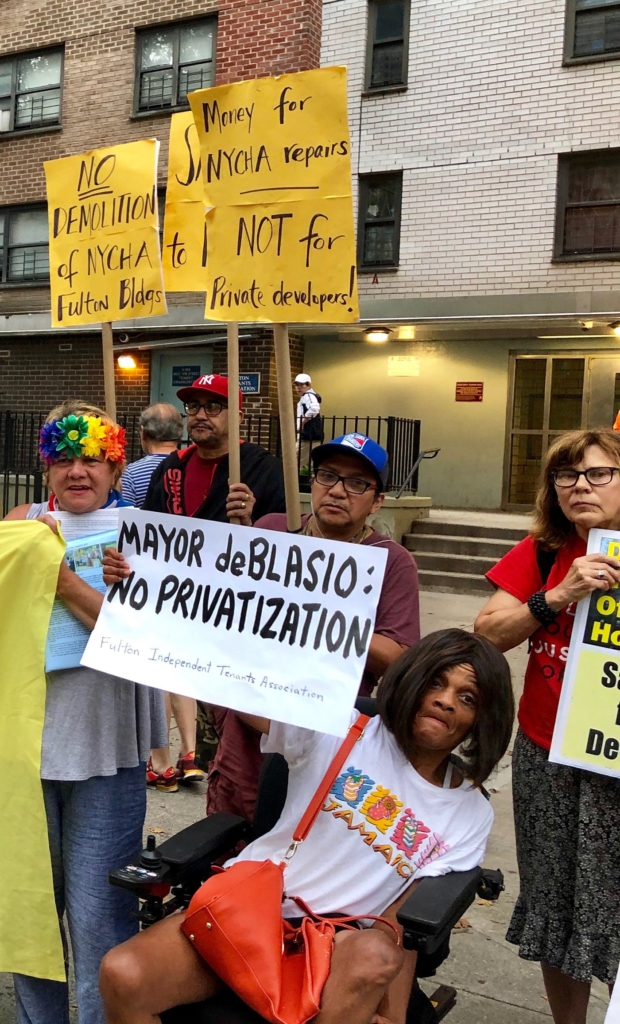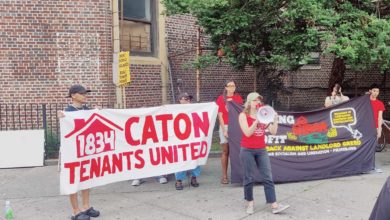This week the streets of Chelsea, New York City, rang twice with the voices of New York City Housing Authority tenants at Fulton Houses and their supporters. They are angry at Mayor Bill de Blasio’s plans to go ahead with plans to demolish two perfectly viable NYCHA buildings on their campus and replace them with 70 percent “market rate” apartments.
The first protest, on Aug. 19, was outside the Spectrum NY1 TV station, where the mayor is interviewed weekly. Protesters chanted, “No demolition, public housing is not for sale!” “Fulton unidos, jamas seran vencidos!” and “Fund repairs not developers!”
Mary McGee, president of the Fulton Independent Tenants Association, roused the crowd when she exclaimed: “Our fight is just beginning … we are not going to stand for privatization and we’re not going to stand for demolition.”
Feeling the heat of the mayor’s expressed intent to proceed with a Sept. 18 date to request proposals from developers for demolition and redevelopment, and inspired by the success of the NY1 protest, the tenants called for a vigil and march through the community four days later.
Starting from Fulton Housing, the determined marchers went through the nearby Ellio-Chelsea NYCHA campus, ending with a vigil and rally at a memorial plaque for Bayard Rustin at Chelsea’s Penn South co-op. Rustin was a well-known civil rights fighter and key organizer of the world-famous March on Washington for Job and Justice in 1963. Rustin lived in Penn South, a limited equity, affordable co-op with strong trade union roots.
Tenants, community oppose mayor’s plan
Neither public housing tenants nor other community members support the mayor’s plan. FITA has collected over 500 signed petitions from Fulton tenants opposing the mayor’s plan. This represents a majority of the 944 rental units at Fulton, and more petitioning is on the way. Tenants, desperate for long-delayed repairs to NYCHA apartments, don’t trust NYCHA management or city government.
In addition, community petitioners have found that Chelsea residents, and Penn South cooperators in particular, overwhelmingly support the struggle of Fulton Housing tenants against privatization, and oppose more gentrification in their already over-gentrified neighborhood.
FITA explained in a press release: “Funding for public housing in the United States has declined due to the government’s unwillingness to support poor and working-class people. NYCHA tenants have been suffering from lead paint, toxic water, lack of heat and hot water, broken elevators and decaying unrepaired buildings. What is more, NYCHA management has been exposed for hiding these issues.”
RAD promises are false
Mayor de Blasio, is running around the country claiming he is the “working peoples’ candidate” for U.S. president. Many at his home base, however, see him as siding with real-estate developers against working people. He plans to sell off a third of NYCHA, some 62,000 units, to real-estate developers under the program misnamed Rental Assistance Demonstration. Fulton Houses is on the cutting edge of this program, and would experience the first demolition of perfectly good housing in NYCHA’s history.
Under RAD, NYCHA’s administrators will invite private companies to build on NYCHA land, to administer the new residential building, and to charge market rates for most units while receiving both tax breaks and more money for a small number of subsidized apartments for some low-income workers. Conversions under RAD would be monitored by the U.S Department of Urban Development.
To accomplish this, de Blasio appointed as new head of NYCHA a privatization cheerleader for RAD, Gregory Russ, at a salary over $400,000, triple his former salary in Minneapolis and nearly double the salary of the previous NYCHA president.

Knowing that privatization is a dirty word today, the mayor claims that he doesn’t want “privatization,” just a “public-private partnership.” He has waged a slick propaganda campaign to convince NYCHA tenants and the public that privatization would fix the deteriorating conditions in public housing.
The facts, however, show that a better name for de Blasio’s plan would be Profit Assistance Demolition (PAD), not RAD.
Program brings rent increases, poor services, evictions
Regarding federal monitoring to make sure the private landlords do the right thing, a study by the federal Government Accounting Office, revealed that HUD has neither the capacity nor the plans to fully monitor RAD sites.
Regarding performance, six of the 14 GAO focus groups of tenants that went through RAD conversions in other cities said that renovations were of poor quality. Residents in 11 of the 14 focus groups complained about poor property management by private real-estate companies. Of the 26,000 households affected by RAD, 57 percent had a rent increase.
The National Housing Law Project reports RAD corporate managers and owners illegally interfered with tenants’ ability to organize, illegally re-screened tenants for readmission, and illegally evicted.
In response to growing community opposition, there has been no shortage of “new” proposals. Manhattan Community Board 4, where Fulton Houses is located, proposed “no demolition” at Fulton but a “rezoning” of all NYCHA housing in their district to build “mixed income” high-rise apartments on “underutilized” NYCHA land. But the mayor rejected even this plan, and intends to proceed with the original demolition plan.
All current plans assert that NYCHA will still “own” the buildings, but that they would be administered by private companies, so it isn’t privatization. But if a farmer hires a fox to administer his chicken coop, what does “ownership” matter?
Real-estate developers given billions in tax breaks
This same city government seeking to impose RAD on working people wanted to give the mega corporation Amazon billions of dollars in tax breaks to invade Queens until it was stopped by workers and trade unions.
The city and state administrations even allowed the “rezoning” of Harlem to enable development money meant for housing for working-class people there to be rerouted to Hudson Yards. Also located in Chelsea, this is a mega-development of corporate headquarters, shops and luxury apartments, where rents run from $5,000 to $20,000 per month. New York State gerrymandered a map to qualify Hudson Yards for $1.6 billion in financing meant for low-income areas by threading it to public housing in Harlem, according to an April 21 report in CityLab. It then gave corporations moving into the Hudson Yards complex billions of dollars in tax breaks.
‘Care package for real estate’
These are just some of the reasons why Fulton tenants see RAD as “a care package for the real-estate industry” at their expense. The problem for developers and Mayor de Blasio is that they have absolutely no credibility with the people, who know that if the mayor was as determined to fix NYCHA as he is to please private developers, the money would be found to do so.
Encouraged by the solidarity from the community, the determination of the tenants and the need to expand the struggle for needed NYCHA repairs without privatization or demolition, the Fulton tenants are planning more events, more meetings, and more protests to demand money to make needed repairs for NYCHA housing. The struggle in Chelsea is one front of a citywide fight for safe, quality, affordable housing for all.






